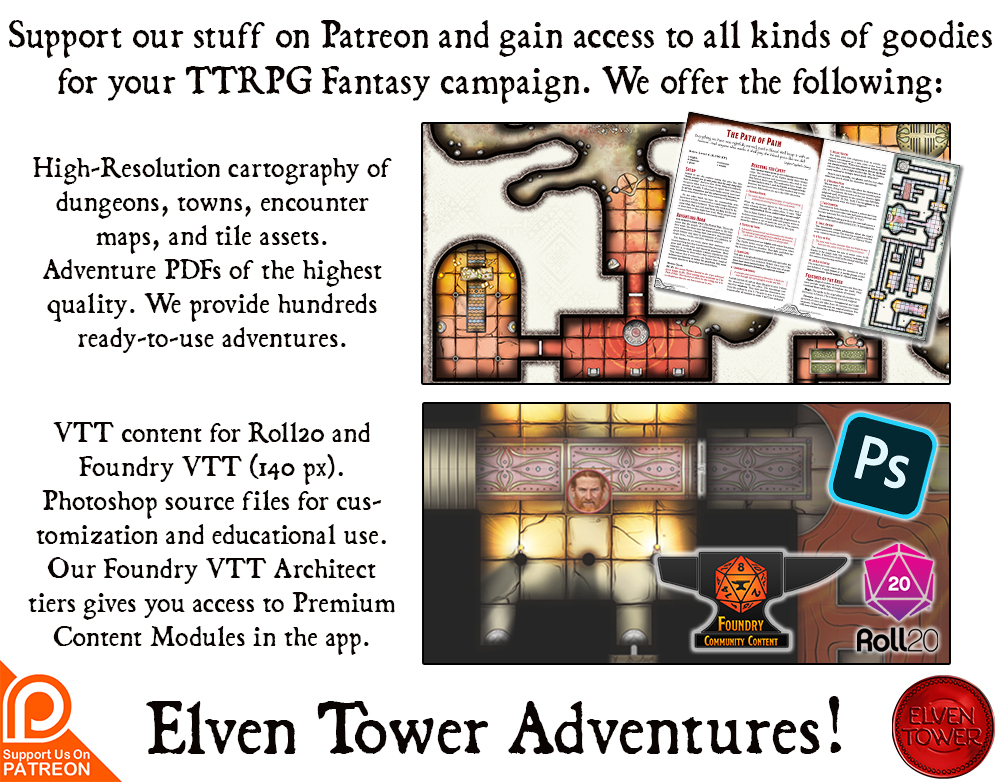 DON’T FORGET TO VISIT OUR MAP INDEX AND OUR PATREON FUNDING PAGE
DON’T FORGET TO VISIT OUR MAP INDEX AND OUR PATREON FUNDING PAGE
About this Resource
This resource features the general description of an adventure location for RPG adventures or general inspiration. Not all releases are the same; some may include rules material for Dungeons and Dragons 5e but mechanics are left to a minimum.
These adventure ideas that are appropriate for low to mid-level (Levels 1 to 5) adventuring parties. As the DM, you are free to change or modify any or all the information found here. NPC names and settlement names are the first you should consider changing to accommodate any homebrew-world lore.
When monsters are referenced, the creature’s name is noted in bold. Only creatures from the D&D5e Monster Manual are cited.
Background Lore
There are few techniques for saving food for a harsh winter better than manufacturing flour. In medieval times, in regions where the winter is a force to be reckoned with, getting ready for the sterile cold season is a matter of life and death. Many people die every year from exposure and lack of resources. There are some places that become isolated corners of the world after winter hits. Being appropriately ready for such a situation is the bread of cold region dwellers. However, it is not enough to save enough food for the winter. The winter is long and while the cold helps, not everything can last for months until the next harvest. That is why people have developed conservation techniques for food and the manufacture of food products which withstand the passage of time better; one of them is flour.
Corn flour, if properly stored, can last 8 to 12 months. Enough to manage through the harshest of winters. Rice flour has a lower shelf life of 6 to 8 months under the same conditions, which is also enough time for most townsfolk trying to make it to the first spring’s harvest.
Flour is manufactured by grinding corn, rice, or other grains into a fine powder. The process is usually done on mills. The local mill is on the outskirts of the town, next to a low-current stream. Don Yara owns the mill and a house right next to it. The mill was built by his grandfather originally and was passed down to his father and then to him a few years back.
This mill is an integral part of town life and a source of food and wealth to everyone in town. Excess products are a relatively expensive commodity to sell to nearby towns and cities during the hot seasons. It is a water-propelled mill. The original mechanical design was an idea of Don Yara’s grandfather. The design has been replicated in other parts of the province too. The mill’s main wheel rotates thanks to the stream’s current. This development is important as it requires no energy input. On the other hand, other mill designs made use of beasts of burden or even people to move the mill.
The main wheel’s movement replicated by a 10-feet-long cog in the interior of the first story. This cog is connected to another one which rotates the mill’s main pole. The rotation of this pole gives energy to two different grinding mechanisms in the second and third story. The milling process starts on the third floor, an employee places dry grain on the mill. The grain is milled twice before reaching the collection bin on the first floor.
Don Yara and his son Garu cannot operate the mill alone, they employ two young lads too. Don Yara invites the two young lads to his home every afternoon for dinner. The work is hard, the pay is low, but such is life in a small town. Inside Don Yara’s home, there are a bunk bed, a wardrobe, a bookcase, a dining table for eight (seldom full), and a hearth with two seats.
Adventure Ideas
- Don Yara does not have a proper storage place. Thus, sacks of flour are an easy steal from the mill. Don Yara wishes to hire a group of adventurers to stake out his mill and catch the thief who already stole two sacks.
- The water mill had a malfunction and one of the main cogs is broken. There is no artisan in town with the expertise to build a new cog. Don Yara wishes to hire the party to take the broken cog to a blacksmith in the nearest city, pay for a new one, and bring it back a few weeks before winter arrives.
- A group of criminals broke into the mill to steal sacks of flour. The townsfolk caught them and the criminals are hiding inside the mill. They are armed with swords and wooden shields. The townsfolk double them in numbers but do not want to risk their lives. The town hires adventurers to solve this problem.
- The stream that powers the water mill suddenly lost strength and the main wheel has stopped. The water also acquired a slightly green coloration. Something has happened. The town is in danger because the mill will not work and the water supply is almost dry. Don Yara hires the adventurers to travel upstream and discover the source of the problem.
- Don Yara’s son, Garu, was kidnapped by a group of road brigands. They are asking for a ransom in flour sacks so large that the town will be crippled during the winter. Don Yara is inclined to pay the unreasonable price because he loves his son, but the townsfolk have prevented him from accepting. The townsfolk suggest hiring a team of strong adventurers to reason with the brigands one way or the other. The life of Garu is of most importance, they say.
General Features
These are the general features of the town’s water mill. It is located in the outskirts of a town, next to a slow current stream. The mill is three stories high. The house of the mill owner is right next to the mill.
Terrain. The area by the mill consists of rolling hills with a few trees. Inside the buildings, movement may be impeded by the presence of furniture and other objects. Squares which contain any obstacle are considered difficult terrain for the purposes of tactical movement.
Doors. The entrances to both buildings are wooden doors with simple locks. The owner carries both keys on a key ring by his belt. A successful DC 14 Dexterity (Thieves Tools) check allows a character to open any of the doors.
Light. Lighting conditions outdoors depend on the weather and time of day. Both the house and the mill have windows in each story. The also feature torch sconces on the walls.
Smells and Sounds. Inside the mill, the powdered grain infuses the air with its smell. The flour is so fine that it may cause trouble breathing after an extended period of time working at the mill (at least a few months). The sound of the ever turning cogs in the mill machinery permeates the building. There are, of course, levers capable of isolating the 2nd and 3rd-floor sections of the device to stop them. from moving. The lower portion of the mill, the main wheel, never stops its motion.


